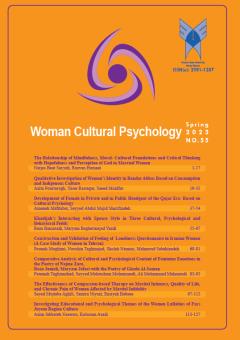Investigating Educational and Psychological Themes of the Women Lullabies of Fars Juyom Region Culture
Subject Areas : Persian the literature
Azim Jabbareh Naserou
1
![]() ,
Kolsoum Asadi
2
,
Kolsoum Asadi
2
![]()
1 - Associate Professor, Department of Persian Language and Literature, Faculty of Literature and Humanities, Jahrom University, Jahrom, Iran.
2 - Bachelor of Persian Language and Literature, Faculty of Literature and Humanities, Jahrom University, Jahrom, Iran.
Keywords: lullabies, educational themes, Psychological themes,
Abstract :
The purpose of the current study was to investigate the educational and psychological themes of women lullabies of Fars Juyom region culture. The research population included all Juyom region of Fars women. The sample subsumed 23 aged women (older than 50 years) whom were selected via purposive sampling procedure. Then all were being interviewed. The research method was descriptive-analytical. Both field and library methods were used to collect data. In the first step, the educational and psychological concepts of the lullabies related to folklore culture were investigated. Then the educational and psychological themes of women lullabies of Fars Juyom region were considered. The findings revealed that based on child psychology the lullabies were not just a song to put the child to sleep, rather, lullabies had an effect on the child's progress and growth rate, increasing loving relationships between parents and children in families. The use of lullabies had an effect on relieving worries, treating mental disorders and psychological well-being of mothers. From a psychological point of view, lullabies provided a psychological, emotional and intellectual situation in which the mother expressed her hopes and dreams. Also, in the ancient region of Joym, lullabies for women were not just a song to put the child to sleep, but lullabies were like a medium through which women expressed their desires, wishes, prayers, curses and protests. In fact, lullabies had a hidden function in addition to the obvious function of a mother's song to put the child to sleep. Lullabies Joym's region were full of emotional and maternal aspect, which was visible in different levels of lullabies.
Berry, J. W., & Worthington, E. L. (2001). Forgiveness, relationship quality, stress while imagining relationship events, and physical and mental health. Journal of Counseling Psychology, 48, 447–455. URL: https://doi.org/10.1037/0022-0167.48.4.447
Enayat, H., Hosseini, M., & Aska Ri Chaverdi, J. (2013). Women's media lullabies or children's sleepy melodies?. Women in Culture and Art, 3(2), 76-57. [Persian] URL: https://www.sid.ir/paper/160656/fa
Fotuhi, M. (2018). Stylistics of theories, approaches and methods. Tehran: Sokhan. [Persian] URL: https://www.gisoom.com/book/11226958/
Fromm, E. (1973). The anatomy of human destructiueness. New York: Holt, Rinehart & Winston. URL: https://www.cambridge.org/core/journals/horizons/article/abs/
Friedman, S. H., Kaplan, R. S. & Rosenthal, M. B. (2010), Music therapy in perinatal psychiatry: Use of lullabies for pregnant and postpartum woman with mental illness. Journal of music and medicine, 2(4), 219- 225. URL: https://mmd.iammonline.com/index.php/musmed/article/view/MMD-2010-2-4-5
Friedberg, J. P., Adonis, M. N., Von Bergen, H. A., & Ferkauf, S. S. (2005). Short communication: september 11th related stress and trauma in New Yorkers. Journal of Stress and Health, 21, 53–60. DOI: 10.1002/smi.1039
Hasanli, K. (2003). Velvet Lullabies; A look at the origin and themes of Iranian lullabies. Journal of Persian Language and Literature of the University of Sistan and Baluchestan, 3(4), 80-61. [Persian] URL: https://www.sid.ir/paper/473423/fa
Horney, K. (1945). Our inner conflicts. New York: Norton. URL: https://www.scirp.org/(S(351jmbntvnsjt1aadkposzje))/
Jamali, E. (2002). Lullabies in the culture of Iranian people. Tehran: Seda Va Sima. [Persian] URL: https://www.gisoom.com/book/1819098/
Josephson, J. (2008). Languages from the Gradle (The Lullabies of Europe). Retrieved June 27. URL: http://www.merlot.org/merlot) view
Khodaei-Majd, V. (2012). Direction toward the development of psychological thinking in Iran during the 20th century. Doctoral dissertation. Baku State University. [Persian] URL: https://journals.iau.ir/article_519721_111899.html
Khodaei Majd, V., & Bakhshali-Of, A. (2012). Examining psychological dimensions of children educational traditional pattern in Iranian Families. Woman and Family Study, 4(15), 81-106. DOI: 20.1001.1.27831787.1400.3.2.6.7
Lakoff, R. (1990). Talking power: The politics of language in our lives. New York: Basic. URL: https://www.amazon.com/Talking-Power-Lakoff-Robin-Tolmach/dp/0465083595
Mahjoub, M. (2008). Popular literature of Iran. by the efforts of Hasan Zulfiqari. Tehran: Chashme. [Persian] URL: https://www.iranketab.ir/book/13281-folk-literature-of-iran
Mohammadi, M. & Ghayini, Z. (2002). History of Iranian children's literature. Tehran: Chista. [Persian] URL: https://www.gisoom.com/book/11453841/
Rahimzadeh, S., Poureatamad, H. R., Asgary, A., & Houjat, M. R. (2011). Conceptual Bases of Loneliness- Feeling: A Qualitive Study; Developmental Psychology. Iranian Psychologist, 8(30), 123-141. URL: https://jip.stb.iau.ir/article_512260.html?lang=en
Sabet, A. (2015). Common terms and compliments among Shirazi women. Farhang Mendor, 5(17), 43-63. [Persian] URL: https://www.noormags.ir/view/ar/articlepage/13376/164/text
Sipak, P. (2013). Iranian folklore literature. translated by Mohammad Akhgari. Tehran: Soroush. URL: https://www.gisoom.com/book/1367069/
Taqavi, K. (1996). Juyom Shahr Salehan. Shiraz: Rahgosha. [Persian] URL: https://www.gisoom.com/book/1103270/
Zeinali, S. (2015). Popular literature and a look at the lullabies of Azerbaijan. Meeting of the Persian Language and Literature Promotion Association of Iran, 6(11), 169-145. [Persian] URL: https://www.sid.ir/paper/846103/fa
Zolfaqhari, H. (2016). General Language and Literature of Iran. Tehran: Samt. [Persian] URL: https://www.gisoom.com/book/11165984/
Zolfaqhari, H., & Dehghan Tazarjani, M. (2023). Critical analysis of the discourse of lullabies based on Farklaf's theory with a gender perspective (case study: lullabies of Yazd). Kavosh Nameh Scientific Quarterly, 4(53), 177-210. [Persian] URL: http://kavoshnameh.yazd.ac.ir/article_2711.html
Zolfaqhari, H., & Dehghan Tazarjani, M. (2022). Female style in lullaby texts. Journal of Interdisciplinary Literary Research, 3(5), 133-164. [Persian] URL: https://lir.ihcs.ac.ir/article_5940.html
_||_

